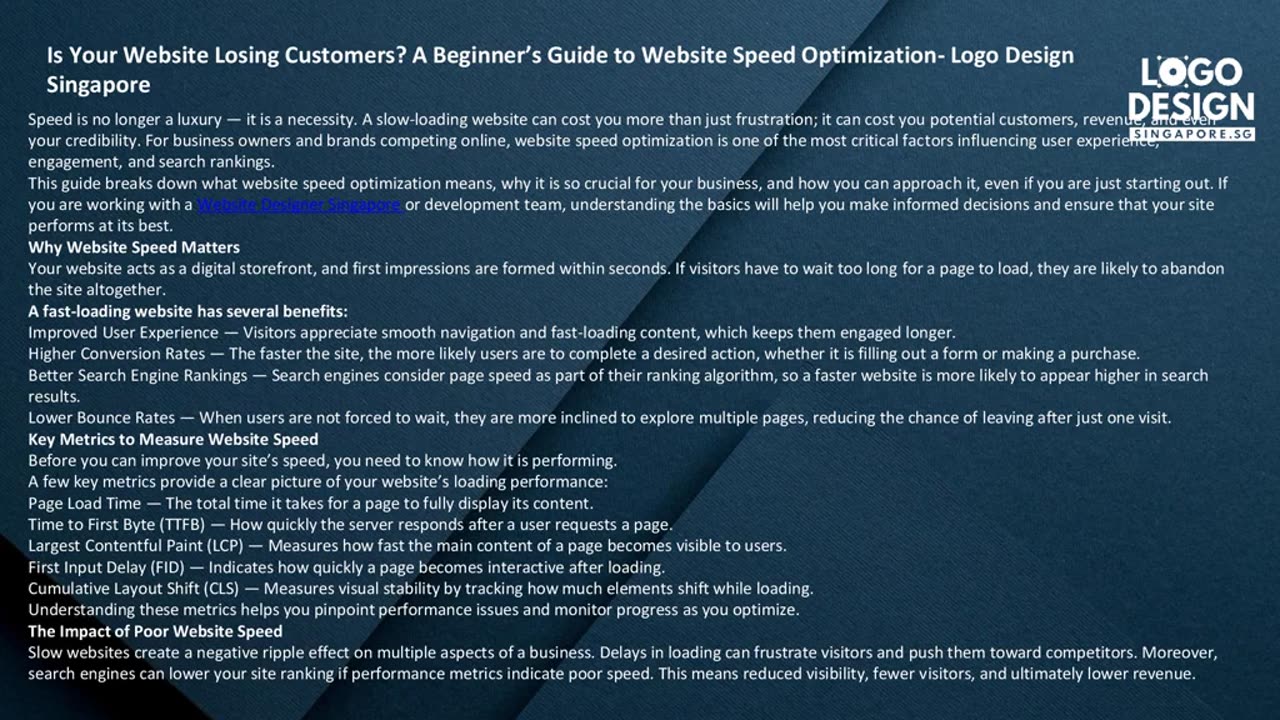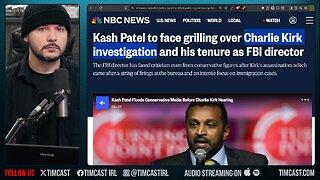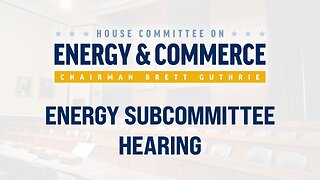Premium Only Content

Is Your Website Losing Customers? A Beginner’s Guide to Website Speed Optimization
Speed is no longer a luxury — it is a necessity. A slow-loading website can cost you more than just frustration; it can cost you potential customers, revenue, and even your credibility. For business owners and brands competing online, website speed optimization is one of the most critical factors influencing user experience, engagement, and search rankings.
This guide breaks down what website speed optimization means, why it is so crucial for your business, and how you can approach it, even if you are just starting out. If you are working with a Website Designer Singapore or development team, understanding the basics will help you make informed decisions and ensure that your site performs at its best.
Why Website Speed Matters
Your website acts as a digital storefront, and first impressions are formed within seconds. If visitors have to wait too long for a page to load, they are likely to abandon the site altogether.
A fast-loading website has several benefits:
Improved User Experience — Visitors appreciate smooth navigation and fast-loading content, which keeps them engaged longer.
Higher Conversion Rates — The faster the site, the more likely users are to complete a desired action, whether it is filling out a form or making a purchase.
Better Search Engine Rankings — Search engines consider page speed as part of their ranking algorithm, so a faster website is more likely to appear higher in search results.
Lower Bounce Rates — When users are not forced to wait, they are more inclined to explore multiple pages, reducing the chance of leaving after just one visit.
Key Metrics to Measure Website Speed
Before you can improve your site’s speed, you need to know how it is performing.
A few key metrics provide a clear picture of your website’s loading performance:
Page Load Time — The total time it takes for a page to fully display its content.
Time to First Byte (TTFB) — How quickly the server responds after a user requests a page.
Largest Contentful Paint (LCP) — Measures how fast the main content of a page becomes visible to users.
First Input Delay (FID) — Indicates how quickly a page becomes interactive after loading.
Cumulative Layout Shift (CLS) — Measures visual stability by tracking how much elements shift while loading.
Understanding these metrics helps you pinpoint performance issues and monitor progress as you optimize.
The Impact of Poor Website Speed
Slow websites create a negative ripple effect on multiple aspects of a business. Delays in loading can frustrate visitors and push them toward competitors. Moreover, search engines can lower your site ranking if performance metrics indicate poor speed. This means reduced visibility, fewer visitors, and ultimately lower revenue.
A sluggish site can also harm your brand image. Visitors may perceive your business as outdated or unreliable, even if your products or services are excellent. Over time, this can damage trust and make it harder to retain loyal customers.
Common Factors Affecting Website Speed
Many variables contribute to a site’s performance. Knowing these factors can help you collaborate better with your Website Designer Singapore or developer to find solutions.
Server Performance — If the hosting server is slow or overloaded, your website will suffer regardless of how well it is designed.
File Sizes — Large media files and unoptimized code can significantly slow down loading t imes.
Unnecessary Plugins or Scripts — Too many third-party tools can weigh down your site.
Caching Issues — Without proper caching configurations, browsers must reload all data every t ime a user visits a page.
Content Delivery Method — Serving content from a single location can create delays for users accessing the site from faraway regions.
Identifying which of these areas is slowing down your site is the first step toward improvement.
Beginner-Friendly Approaches to Speed Optimization
The good news is that website speed optimization does not require advanced technical knowledge to get started. Several best practices can make a noticeable difference:
Optimizing Hosting Setup
Choosing a reliable hosting provider with strong performance can reduce server response t ime and improve load speed.
Streamlining Website Code
Clean, efficient code ensures browsers can process and display pages quickly. Minimizing unnecessary elements and removing redundant scripts can significantly boost performance.
Enabling Browser Caching
Caching allows browsers to store certain parts of a website so that they do not need to be downloaded again on repeat visits.
Using a Content Delivery Network (CDN)
A CDN distributes website content across multiple servers around the world, ensuring that users access data from the nearest location.
Compressing Images and Files
Reducing file sizes without sacrificing quality can dramatically improve page load time.
Optimizing for Mobile Devices
A large percentage of users access websites on smartphones. Ensuring a mobile-friendly design that loads quickly on smaller screens is critical.
The Role of a Website Designer in Speed Optimization
Working with a skilled Website Designer Singapore can make the entire process smoother. A designer who understands performance best practices will ensure that your site is not only visually appealing but also optimized for speed.
The designer’s responsibilities can include:
Creating lightweight layouts that do not overload the browser.
Choosing typography and visual elements that maintain balance between aesthetics and performance.
Collaborating with developers to implement efficient code structures.
Testing responsiveness to ensure a consistent experience across devices.
A well-informed Website Designer understands that speed is part of user experience and integrates optimization into the design process from the very beginning.
Balancing Speed with Design
While it may be tempting to add elaborate animations or heavy visual features, speed should always remain a priority. Striking a balance between design and performance is essential. Overloading a site with unnecessary elements may create a stunning visual display, but if it slows loading time, visitors may never stay long enough to appreciate it.
When working on your website, aim for simplicity and clarity. A clean layout, concise content, and thoughtfully chosen images can look professional and help maintain fast loading times.
Ongoing Maintenance for Lasting Performance
Website speed optimization is not a one-time task. As your business grows, you may add new pages, media, or features that can gradually slow performance. Regular monitoring ensures that your site continues to deliver the best experience.
Establish a routine for:
Tracking performance metrics regularly.
Updating plugins, themes, and scripts to their latest versions.
Removing outdated content or unused files.
Reviewing hosting plans as traffic increases.
Consistent maintenance keeps your site performing at its peak and reduces the risk of losing potential customers due to avoidable delays.
Final Thoughts
In today’s digital environment, speed is a critical factor that directly impacts your website’s ability to attract and retain customers. Understanding the basics of website speed optimization allows business owners and marketers to make informed decisions that strengthen online presence and improve results.
Partnering with a knowledgeable Website Designer Singapore ensures that speed is prioritized alongside aesthetics. By taking proactive steps to monitor and enhance your site’s performance, you can create a seamless experience that keeps visitors engaged, improves search rankings, and ultimately drives more conversions.
If your website feels slow, now is the time to act. The sooner you address performance issues, the sooner you can stop losing potential customers and start turning your site into a powerful, high-performing tool for your business.
Pop over here : https://www.logodesignsingapore.sg/freelance-web-designer-singapore/
-
 LIVE
LIVE
The Rubin Report
44 minutes agoListen to the Fear in Whoopi Goldberg’s Voice on 'The View' as She Gives a Chilling Warning
2,538 watching -
 LIVE
LIVE
Benny Johnson
1 hour agoKash Patel Testifying LIVE Now on Charlie Kirk Assassination, Trump to Declare Antifa TERRORISTS?!
6,810 watching -
 2:07:38
2:07:38
Timcast
2 hours ago🚨LIVE: Kash Patel Testifies Over Charlie Kirk Assassination In Senate | Tim Pool
30.1K25 -
 1:01:35
1:01:35
VINCE
2 hours agoThe Left's 'Malignant' Violence Problem | Episode 126 - 09/16/25
72.1K44 -
 LIVE
LIVE
LFA TV
5 hours agoLFA TV ALL DAY STREAM - TUESDAY 9/16/25
4,735 watching -
 1:45:59
1:45:59
Dear America
2 hours agoKiller ADMITS To Killing Charlie In DISCORD. Terror Cell EXPOSED! + JD Fills In on Charlie’s Show!
131K81 -
 LIVE
LIVE
Wendy Bell Radio
6 hours agoThe Left Lives In A Bubble
7,147 watching -
 LIVE
LIVE
Barry Cunningham
2 hours agoLIVE BREAKING NEWS: KASH PATEL HEARING!
1,840 watching -
 LIVE
LIVE
House Committee on Energy and Commerce
1 hour agoAppliance And Building Policies: Restoring The American Dream Of Home Ownership And Consumer Choice
42 watching -
 LIVE
LIVE
The Big Mig™
2 hours agoTrump Declares Antifa Is A Domestic Terrorist Organization
2,543 watching